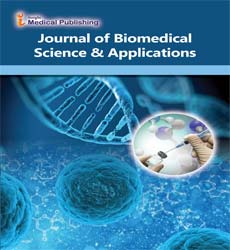Biomedical Imaging Innovations for Translational Medical Applications
David Daniel
Department of Biomedical Balıkesir University, Cagis, Balikesir, 10145, Turkiye
Corresponding author:
David Daniel,
Department of Biomedical Balıkesir University, Cagis, Balikesir, 10145, Turkiye;
Email: david@daniel.tr
Received date: January 01, 2025, Manuscript No. Ipbsa-25-20591; Editor assigned date: January 03, 2025, PreQC No. Ipbsa-25-20591(PQ); Reviewed date: January 15, 2025, QC No. Ipbsa-25-20591; Revised date: January 22, 2025, Manuscript No. Ipbsa-25-20591(R); Published date: January 28, 2025, DOI: 10.36648/ 2471-7975.9.1.03
Citation: Daniel D (2025) Biomedical Imaging Innovations for Translational Medical Applications. J Biomed Sci Appl Vol.09 No.1: 03
Introduction
Biomedical imaging innovations have revolutionized translational medicine by providing advanced tools that bridge laboratory research and clinical applications. Imaging technologies not only facilitate early disease detection and accurate diagnosis but also enable real-time monitoring of treatment responses and progression of various conditions. With continuous advancements in modalities such as Magnetic Resonance Imaging (MRI), Positron Emission Tomography (PET), Computed Tomography (CT), and molecular imaging, biomedical imaging plays a central role in bringing scientific discoveries from the bench to the bedside, thereby accelerating the translation of research into improved patient care [1].
Description
One of the key contributions of biomedical imaging in translational applications is its ability to visualize biological processes at the molecular and cellular levels. Molecular imaging techniques, such as PET and fluorescence-based imaging, allow researchers and clinicians to detect biomarkers and metabolic changes that occur before structural abnormalities become evident. This early detection is critical in diseases like cancer and neurodegenerative disorders, where timely intervention significantly influences patient outcomes. Additionally, multimodal imaging platforms that integrate anatomical and functional data provide comprehensive insights that are invaluable in precision diagnostics and targeted therapies [2]. Biomedical imaging has also advanced therapeutic monitoring and personalized medicine. Techniques such as MRI and ultrasound are increasingly used to assess real-time responses to treatments, including chemotherapy, radiotherapy, and immunotherapy. For instance, diffusion-weighted MRI can detect early changes in tumor cellularity, offering a predictive indicator of therapeutic effectiveness before conventional imaging shows visible changes. Furthermore, image-guided interventions have become standard in minimally invasive surgeries, improving accuracy, reducing complications enhancing patient recovery [3]. These innovations demonstrate how imaging translates directly into better clinical outcomes and individualized treatment planning. Another critical area where biomedical imaging contributes to translational medicine is in research and development of novel therapies. Preclinical imaging allows scientists to study disease mechanisms, evaluate new drugs, and validate therapeutic targets in animal models before moving to human trials [4]. Advanced imaging biomarkers serve as surrogate endpoints in clinical studies, accelerating drug development and regulatory approval. Additionally, the integration of artificial intelligence and machine learning in image analysis enhances pattern recognition, predictive modeling, and automation, thus expanding the diagnostic power and translational potential of imaging technologies [5].
Conclusion
In summary, biomedical imaging innovations are central to translational medical applications, providing the tools needed to detect, diagnose, and monitor diseases while supporting the development and clinical implementation of new therapies. By enabling early detection, personalized treatment strategies, and real-time therapeutic monitoring, imaging technologies serve as a critical bridge between research discoveries and clinical practice. As imaging continues to evolve through molecular techniques, multimodal platforms, and AI-driven analytics, its role in translational medicine will expand, ultimately driving advancements in precision healthcare and improving patient outcomes worldwide.
References
- Spiteri C, Caprettini V, Chiappini C (2020) Biomaterials-Based Approaches to Model Embryogenesis. Biomater Sci 8: 6992-7013
Google Scholar Cross Ref Indexed at
- Karimi R, Yanovich A, Elbarbry F, Cleven A (2024) Adaptive Effects of Endocrine Hormones on Metabolism of Macronutrients during Fasting and Starvation: A Scoping Review. Metabolites 14: 336
Google Scholar Cross Ref Indexed at
- Obeid OA, Hachem DH, Ayoub JJ (2014) Refeeding and Metabolic Syndromes: Two Sides of the Same Coin. Nutr Diabetes 4: e120
Google Scholar Cross Ref Indexed at
- Zeki S, Culkin A, Gabe SM, Nightingale JM (2011) Refeeding Hypophosphataemia is More Common in Enteral than Parenteral Feeding in Adult Inpatients. Clin Nutr 30: 365-368
Google Scholar Cross Ref Indexed at
- Tao E, Zhu Z, Hu C, Long G, Chen B, Guo R, Fang M, Jiang M (2022) Potential Roles of Enterochromaffin Cells in Early Life Stress-Induced Irritable Bowel Syndrome. Front Cell Neurosci 16: 837166
Open Access Journals
- Aquaculture & Veterinary Science
- Chemistry & Chemical Sciences
- Clinical Sciences
- Engineering
- General Science
- Genetics & Molecular Biology
- Health Care & Nursing
- Immunology & Microbiology
- Materials Science
- Mathematics & Physics
- Medical Sciences
- Neurology & Psychiatry
- Oncology & Cancer Science
- Pharmaceutical Sciences
